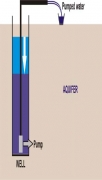The presentation by ACWADAM is part of the training module developed by them on “Planning, development and management of groundwater with special reference to watershed management programmes”. Pumping a well and observing the effect of such pumping on the water level in the pumped well as well as in the adjoining parts of the aquifer through observation wells is the basic procedure involved in a pumping test.
The pumping test usually involves two parts:
- The pumping part during which the water levels in the wells keep falling, called the drawdown phase in a well.
- The period after which water levels in the wells keep falling, called the recuperation or recovery phase in the well.
Measurements for both the drawdown and recovery phases, are made with respect to time. The test data can then be analysed to give values of transmissivity, storage coefficient and the yield or specific capacity. The analysis of pumping test data itself is a very vast subject and involves a lot of detailed analysis of the nature and geometry of aquifers and aquitards, their relationship and variability of properties, which must be known before conducting the test.
Measurements to be taken during pumping tests -
- Water levels in the pumping well and adjoining observation wells or piezometers.
- Discharge rate of the well, i.e. rate at which water is pumped out of the well.
An aquifer performance test is conducted to quantify the aquifer characteristics and estimate aquifer properties like transmissivity and storativity.
like transmissivity and storativity.
The presentation gives details of pumping test equipments and the mechanics of pumping (well hydraulics). It describes concepts such as static and pumping water level, hydraulic gradient, dewatering of aquifers, drawdown, cone of depression, aquifer contribution, relation between outflow and inflow, pumped water level & drawdown, recuperation/recovery and cone of depression.
It also details some of the practical aspects to be noted while conducting pumping tests. The procedure of pumping test data collection and interpretation is described. The aquifer performance tests are described in which drawdown measurements are made with respect to fixed time intervals. The pump discharge is also checked several times during pumping period. The recovery measurements after the pump being shut off are also made at fixed intervals. The interpretation of aquifer test data is described using a simple graphical method by Cooper and Jacob (1964).
The presentation ends with a section on specific capacity - the yielding capacity or the capacity to derive water from the aquifer, whose estimation is the main aim of pumping tests.
This presentation is part of the training modules on planning, development and management of groundwater with special reference to watershed management programmes by ACWADAM. Please write to ACWADAM at acwadam@vsnl.net for sourcing these presentations.
/articles/pumping-tests-wells-means-measuring-storage-and-transmission-properties-aquifers